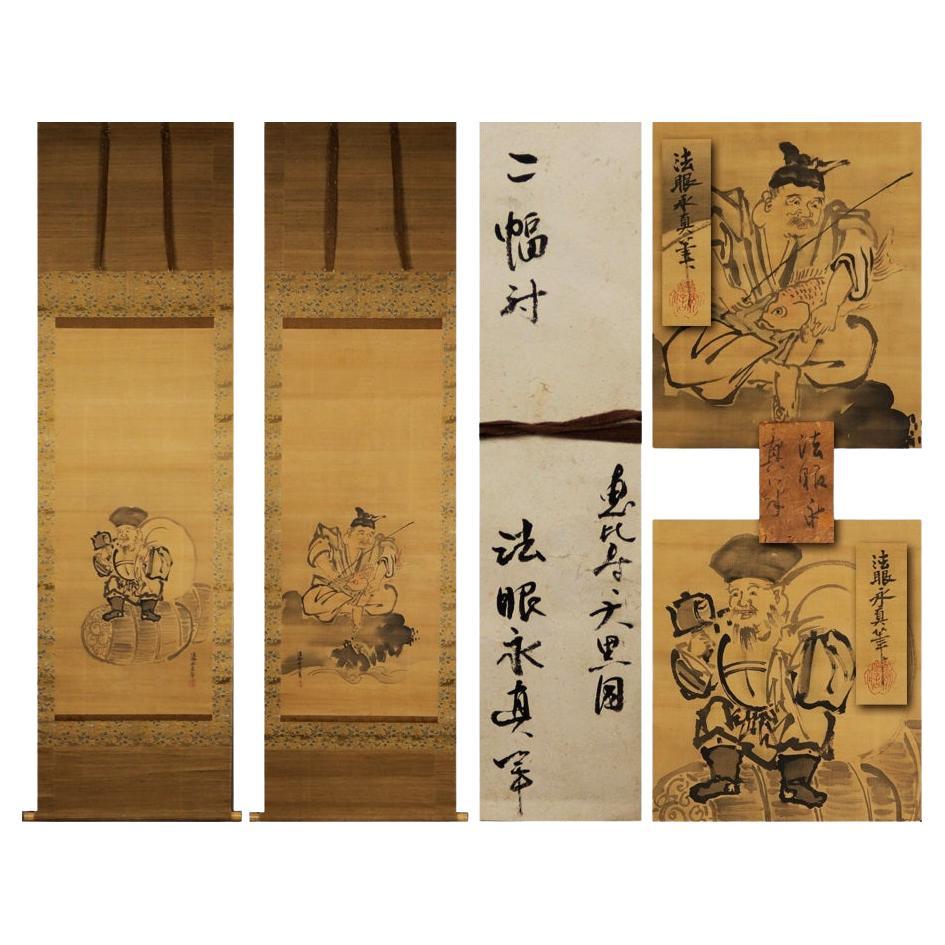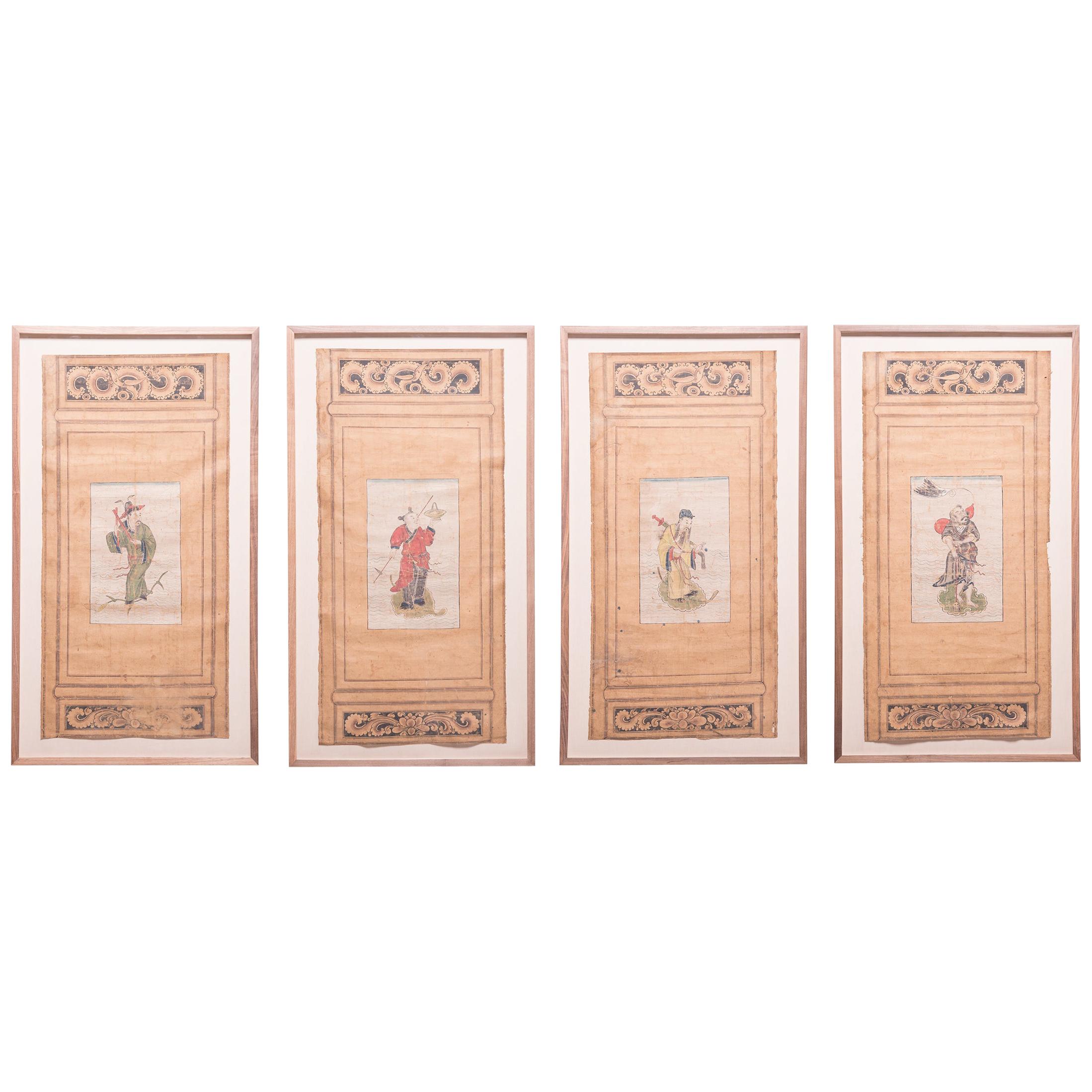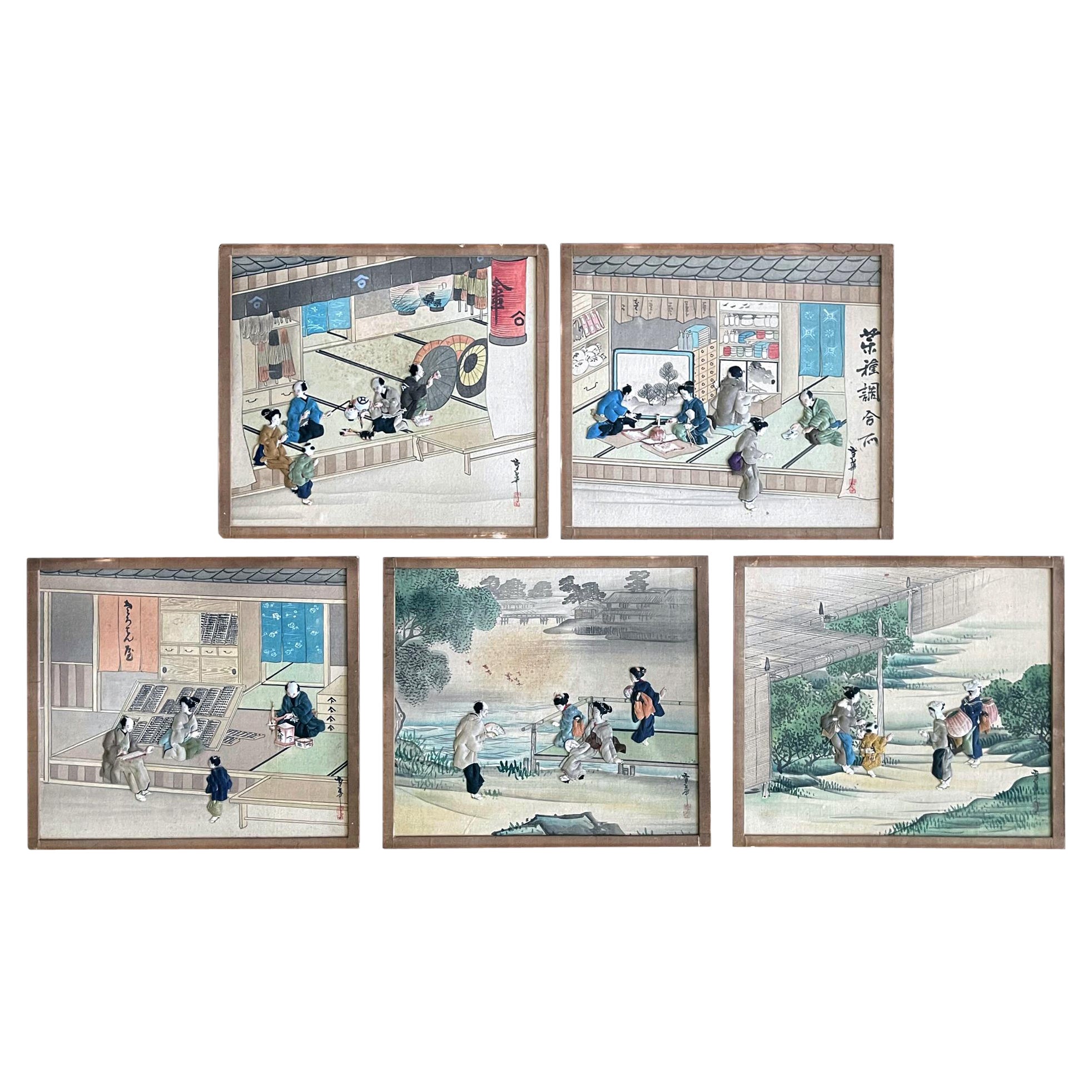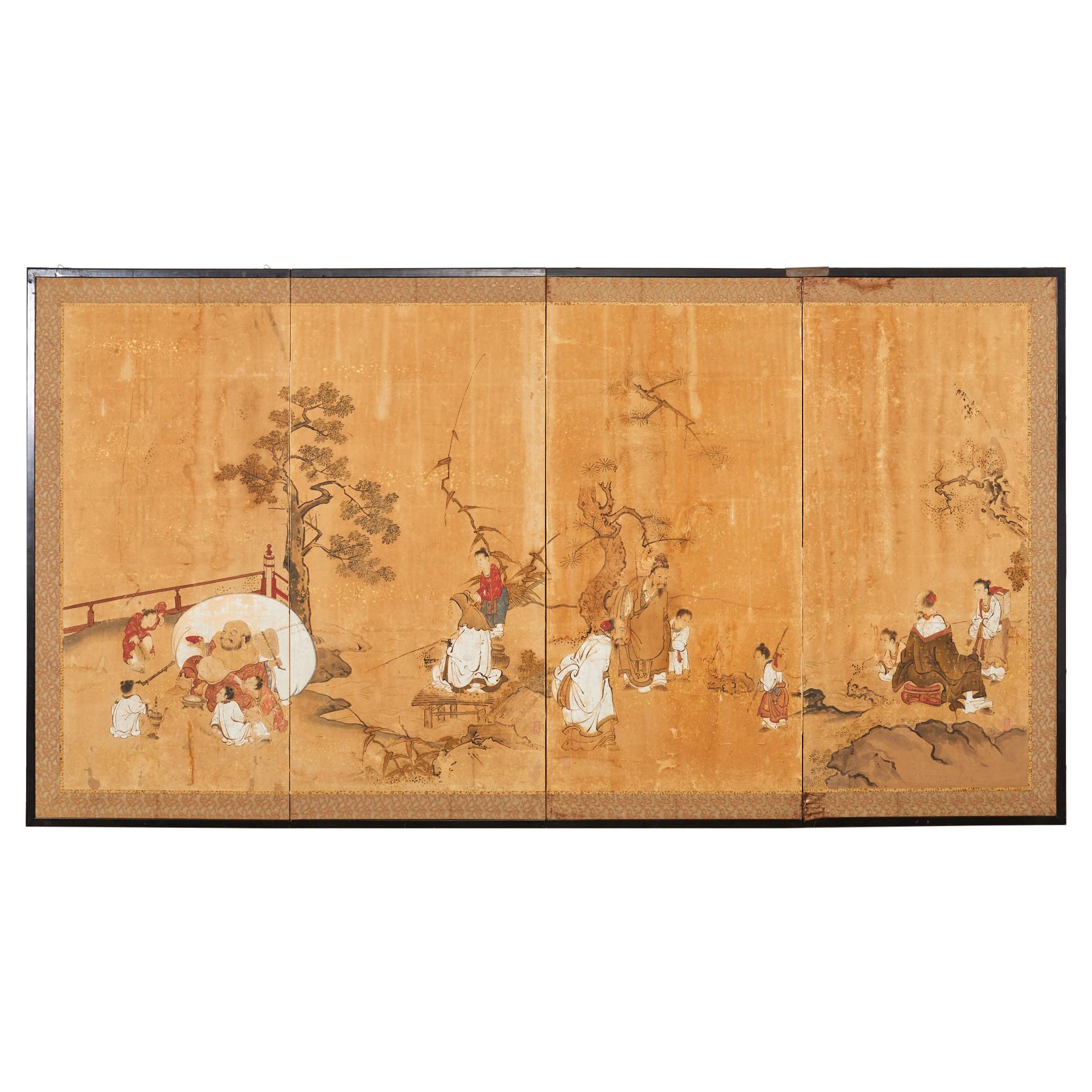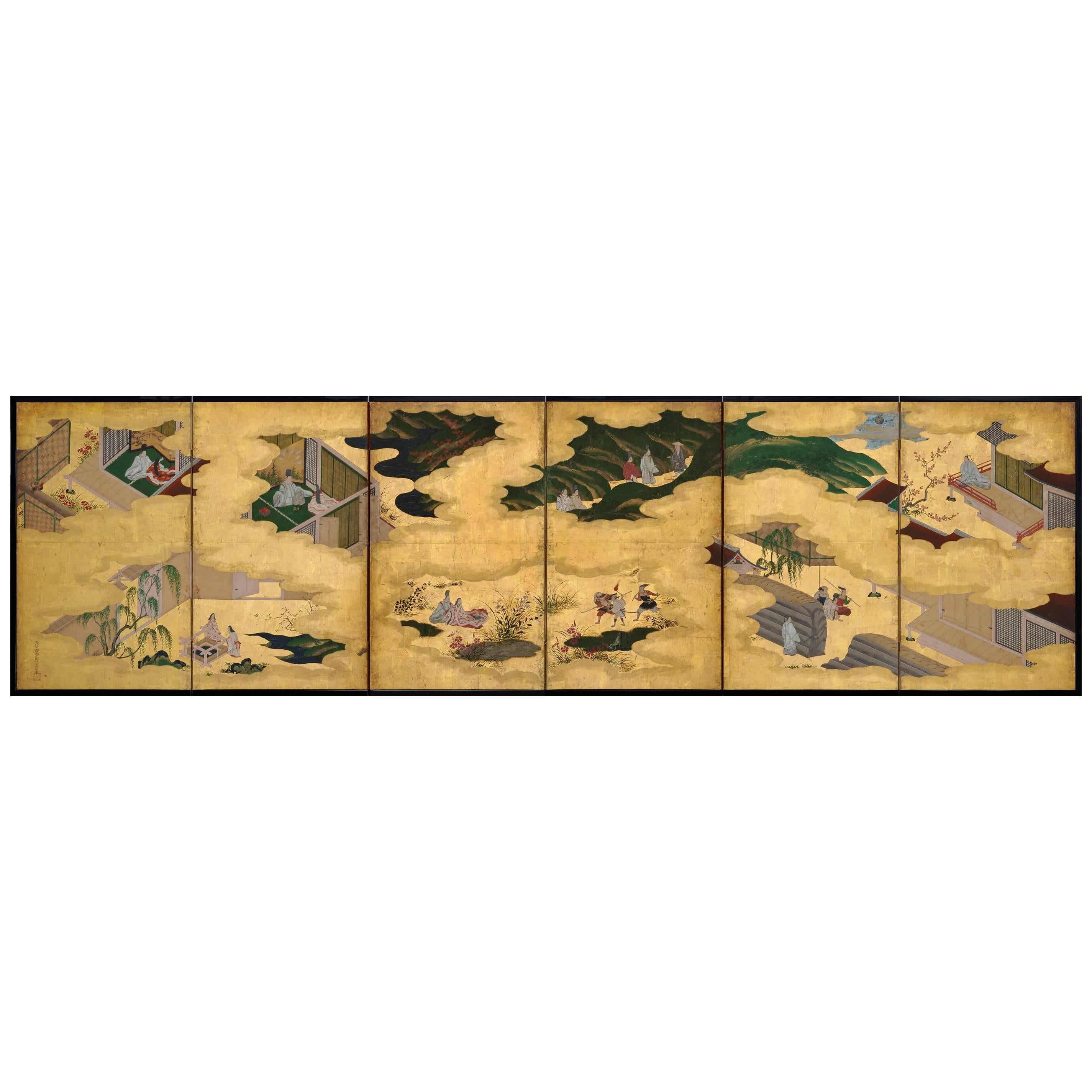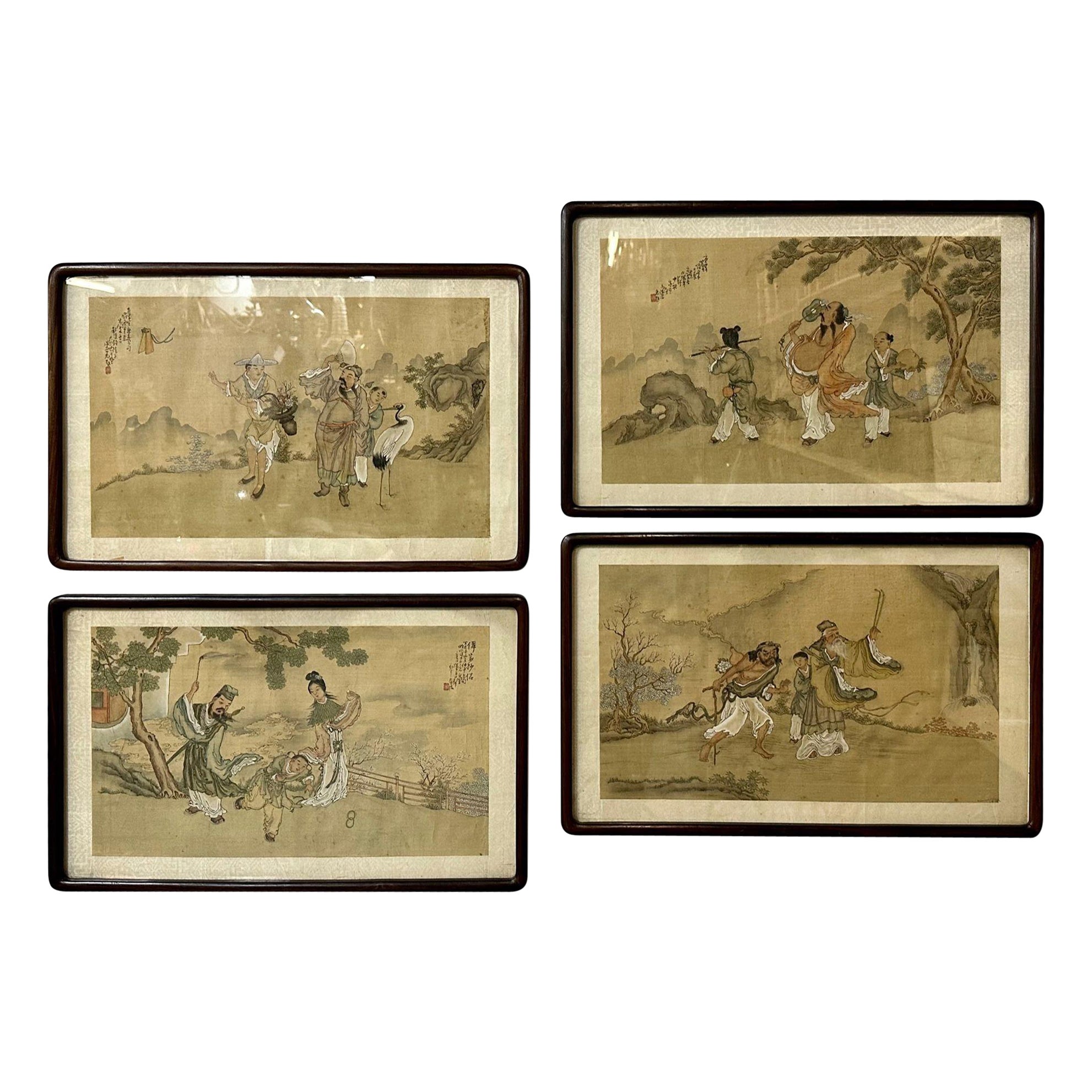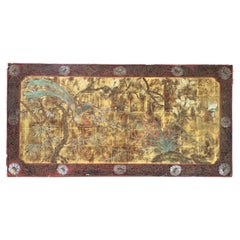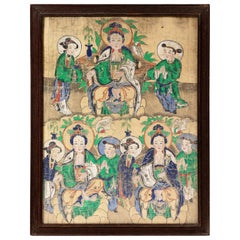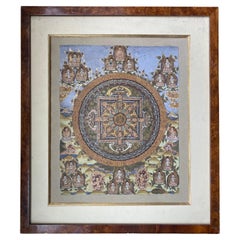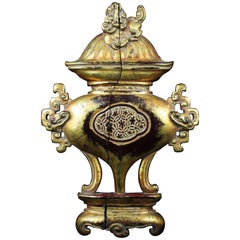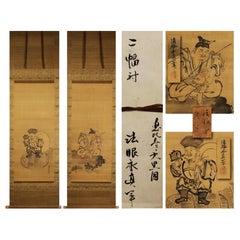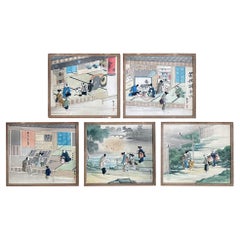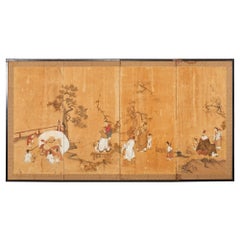Items Similar to Set of 6 Large Kakemonos Japanese Mythology, 19th Century Japan circa 1800 Edo
Want more images or videos?
Request additional images or videos from the seller
1 of 21
Set of 6 Large Kakemonos Japanese Mythology, 19th Century Japan circa 1800 Edo
$3,201.11per set
£2,395.68per set
€2,700per set
CA$4,416.21per set
A$4,911.01per set
CHF 2,579.37per set
MX$60,041.98per set
NOK 32,141.38per set
SEK 30,300.64per set
DKK 20,553.74per set
About the Item
Beautiful set of 6 large kakemonos from 19th century Japanese mythology.
Paper support with a canvas pasted on the paper
Wonderful set that is part of Japan's history and beliefs
When not hung, the Kakemonos are rolled up.
circa 1800 - Japan - Edo Period
A kakemono translates as "object to hang". In Japan this refers to a painting or calligraphy, most often done on silk or paper framed in a scroll that was intended to be hung on walls or in public lighting. This particular form, which allows them to be in a roll, dates back to the Tang dynasty in China (this would be related to the copying and preservation of ancient Buddhist texts). A Kami is a deity or spirit worshipped in the Shinto religion. A Yokai is a spirit, ghost, demon, or strange apparition from the creatures of Japanese folklore.
Each of these kakemonos represents a unique story:
- A kami, a Japanese deity, is shown painting a rainbow. Indeed, he performs the action with his right hand while his left hand holds a kind of basket with three pots of paint. This kami has a rather closed attitude. He is standing in a dark and tormented sky. Below this figure, 8 villagers are dressed in traditional Japanese clothes. Their faces are softened. They are not afraid of the elements made by the kami above their heads.
- A character with an unreal look is holding a kind of jar with his two hands, which he spills on human figures above. This being is floating in the air, probably a character from mythology, perhaps Susanoo. Underneath, villagers on umbrellas. They are trying to protect themselves as best they can from what is falling on them. One of them is carrying baskets with fish on her shoulders. A character in the background is thrown forward and falls.
- On this kakemono, the god Raijin, dressed in a white and blue outfit, strikes the sky with his two drum hammers to create lightning and its thunderous sound. Surrounded by Tomoe and a long red scarf, Raijin, enraged and with dishevelled hair, creates a dark and violent storm. The villagers seem frightened by this meteorological phenomenon. One of the villagers can be seen fainting in the arms of a man. This scene may seem chaotic, but Japanese legend tells us that once a field is struck by lightning, the harvest is good.
- On this kakemono, we see an unreal-looking figure holding a fan, as if he were sweeping away the bad weather, or simply producing gusts of wind. He is probably the kami of wind and air, Shina tsu-hiko. The figures below him seem surprised by so much wind. An umbrella flies away on the left, the women hold their hair and scarf, the clothes are caught in the power of the wind, there is even a woman on the ground on the bottom left.
- This Kakemono represents a short moment. This Raiju is a yokai (ghost spirit, demon from Japanese folklore) that accompanies Raijin, it controls the energy and electricity around and its body is composed of fire or light. Mostly blue in colour, he comes here to create energy and dissipate numerous lightning bolts, taking the villagers by surprise. Some of them even stumble. Traces of old restorations and humidity also
- The kami Kura-Okami seems to be represented, born from the blood of Kagu-Tsuchi (the god of fire according to Japanese mythology, son of Izanami and Izanagi). When Kagu-Tsuchi was born, he burned Izanami to death and Izanagi cut him into 8 pieces which gave birth to 8 deities, and from his blood which flowed on his father's sword 8 other deities were born, including Kura-Okami. Later, Kura-Okami split into two to give birth to Taka-Okami. Both live in the mountains and valleys producing rain and snow. On the kakemono, the kami is making snow fall from the clouds. The characters below are carrying umbrellas for protection. A character is chasing an animal, probably a sheep.
Behind four of them, the same Japanese sign is inscribed at the top, and a different sign on the other two.
- Dimensions:Height: 63.78 in (162 cm)Width: 20.48 in (52 cm)Depth: 0.04 in (1 mm)
- Sold As:Set of 6
- Style:Edo (Of the Period)
- Materials and Techniques:
- Place of Origin:
- Period:
- Date of Manufacture:1800
- Condition:Repaired: Traces of old restorations and humidity also on the one representing the kami of lightning and thunder.
- Seller Location:Beuzevillette, FR
- Reference Number:1stDibs: LU2663326635002
About the Seller
4.9
Vetted Professional Seller
Every seller passes strict standards for authenticity and reliability
Established in 2010
1stDibs seller since 2017
300 sales on 1stDibs
Typical response time: 5 hours
- ShippingRetrieving quote...Shipping from: Nointot, France
- Return Policy
Authenticity Guarantee
In the unlikely event there’s an issue with an item’s authenticity, contact us within 1 year for a full refund. DetailsMoney-Back Guarantee
If your item is not as described, is damaged in transit, or does not arrive, contact us within 7 days for a full refund. Details24-Hour Cancellation
You have a 24-hour grace period in which to reconsider your purchase, with no questions asked.Vetted Professional Sellers
Our world-class sellers must adhere to strict standards for service and quality, maintaining the integrity of our listings.Price-Match Guarantee
If you find that a seller listed the same item for a lower price elsewhere, we’ll match it.Trusted Global Delivery
Our best-in-class carrier network provides specialized shipping options worldwide, including custom delivery.More From This Seller
View AllA.Bouverat Chinese Inspired Lacquered Panel Hand-Painted 20th Century
By A. Bouverat
Located in Beuzevillette, FR
Very beautiful rare and large lacquer of Chinese inspiration. Representation of a green space with many plants such as cherry trees and magnolia. A bird crosses the lacquer with its ...
Category
20th Century French Chinoiserie Paintings
Materials
Lacquer
Immortal He Xiangu Painting on Canvas, China, 19th Century Asian Art
Located in Beuzevillette, FR
Chinese painting depicting He Xiangu reproduced three times but with a different attribute: up a lotus flower, bottom left a fly hunt and bottom right again the lotus flower, each time surrounded by disciple the one praying right, the one on the left seems to bring him a bowl.
Pigments on linen or hemp,
19th century.
He Xiangu or Ho Hsien-ku, "Immortal Demoiselle He," is an immortal Taoist, a member of the group of Eight Immortals. She is represented holding in her hand a lotus symbolizing spiritual fulfillment, and sometimes also a sheng, a peach of immortality, a wooden ladle...
Category
Antique 19th Century Chinese Qing Paintings and Screens
Materials
Canvas
Asian Mandala Tanka circa 1900
Located in Beuzevillette, FR
Very beautiful tanka mandala of the 19th century painted on canvas . Buddha is in the center with the naga on his right arm, surrounded by others arranged like the rays of the sun. T...
Category
Antique 19th Century Asian Paintings and Screens
Materials
Canvas
China 18th Century Chinese Decoration Element in Lacquered and Gilded Wood
Located in Beuzevillette, FR
Interesting element probably coming from a lacquered and gilded wood furniture or panel representing a tripod - shaped vase with curved legs with...
Category
Antique 18th Century Chinese Qing Sculptures and Carvings
Materials
Giltwood, Wood, Lacquer
Small Chinese Black Lacquered Wardrobe 19th Century
Located in Beuzevillette, FR
Pretty XIXth century Chinese wardrobe in black lacquered wood decorated with court scenes, opening with two doors. The interior has a shelf with two drawers decorated with golden plant motifs, the handles of the drawers are decorated with burnt perfume vases.
Category
Antique 19th Century Chinese Chinoiserie Furniture
Materials
Wood
Japan Red Lacquered Box 19th century
Located in Beuzevillette, FR
Beautiful Japanese box in red lacquered wood;
19th century
The lid is decorated with a landscape with a bird, trees and a setting sun.
The inside of the box is covered with a lacque...
Category
Late 20th Century Decorative Boxes
Materials
Wood
You May Also Like
Antique Japanese 17th c Edo Scroll Kano Yosanobu Buddhist Painting
Located in Amsterdam, Noord Holland
Eishin Kano's Ebisu/Great Country Map, double-width/comes with an old box.
The auspicious statues of Ebisu and Daikoku are standing in a double-width hanging scroll with a smiling fa...
Category
Antique 18th Century Edo Paintings
Materials
Silk
$3,412 Sale Price
20% Off
Set of Four Chinese Immortals Screen Paintings, c. 1850
Located in Chicago, IL
Since the 12th century people in China have used folding screens and doors to partition and decorate their homes—the vivid scenes backing the screens added life and color to a room. ...
Category
Antique Mid-19th Century Chinese Qing Paintings and Screens
Materials
Paper
Collection of Five Japanese Oshi-E Textile Art Panels Meiji Period
Located in Atlanta, GA
On offer is a set of five Japanese textile art panels called Oshi-E circa Meiji Period (1868-1912). This usual set of panels depict various aspects of daily life in Edo time with beautiful details. Some of these panels are snapshots of the buzzling commercial activities at the marketplace, providing insight into the signages, architecture, costumes and how people interacted within a historical and pictorial context. Other panels depict daily leisure activities such as lounging in the park or visiting friends. The realistic rendering and attention to details are not short of "photographic" quality. From the signage of the shops to the motions and attires of the individual characters, from the hairstyle, small ornaments, down to the facial expression, were all recorded in great details. Each panel was signed with the artist's name Yukihana in Kanji with a red seal.
These panels are unframed and await your custom touch (framing with inner gilt spacer and mat costs about 250-500 depending on the material chosen, see a framed example in the last picture of a single framed panel we have for sale). We offer them for sale individually, but it will be great for a collector to consider the whole set so that they can stay together.
The Oshi-E (also known as kiritori zaiku) is a type of ornamental textile art dated back to the Muromachi period (1392-1573). It started among the elite aristocratic women in Kyoto before spreading wider in the Japanese society. Throughout Edo and Meiji period, Oshi-E were sometimes used to make offerings to the altars in the temple and in the late 19th century, it was exported to the west along with the other embroidery textile art. Oshi-E was made by using silk wadding to create a relief design. Various silk fabric swaps and sometimes wires and tassels, often recycled from older kimonos...
Category
Antique 1890s Japanese Japonisme Textiles
Materials
Silk, Giltwood
17th Century Japanese Edo Four Panel Screen Hotei with Chinese Sages
Located in Rio Vista, CA
Beautifully weathered late 17th/early 18th century Japanese edo period four panel byobu screen depicting hotei (fat monk) in a treed landscape with Chinese sages engaged in leisurely...
Category
Antique 17th Century Japanese Edo Paintings and Screens
Materials
Brass
Japanese Screen Painting, Circa 1700 'Tales of Ise' by Tosa Mitsusuke
By Tosa Mitsusuke 1
Located in Kyoto, JP
A six-fold Japanese screen by Tosa Mitsusuke (1675-1710), Japan 17th-18th century, Edo period.
The signature reads Shoroku-i ge Tosa sa Konoe Shogen Mit...
Category
Antique Late 17th Century Japanese Edo Paintings and Screens
Materials
Gold Leaf
Set of Four Chinese Paintings in Rosewood Frames, Signed, 19th Century
Located in Manhasset, NY
Set of Four Chinese Paintings in Rosewood Frames, Signed, 19th Century, Oil Canvas
Stunning example of Oriental works on canvas on wood. Each in a fine custom rosewood frame, matted. The set depicting a story of a band leader...
Category
Antique Late 18th Century Renaissance Paintings
Materials
Canvas, Paint
More Ways To Browse
Japanese Fans
Japanese Sword Furniture
Hand Painted Large Pots
Japanese Silk Dress
Japanese Scroll Framed
Chinese Blue And White Pot
Japanese Painted Silk Scroll
Chinese Sword
Woman Carrying Basket
Calligraphy
Buddhist Scroll
Antique Chinese Swords
Japanese Drum
Antique Chinese Hand Fans
Old Japanese Pots
Scene Silk Scarf
Antique Chinese Drum
Japanese Mountain Scrolls
